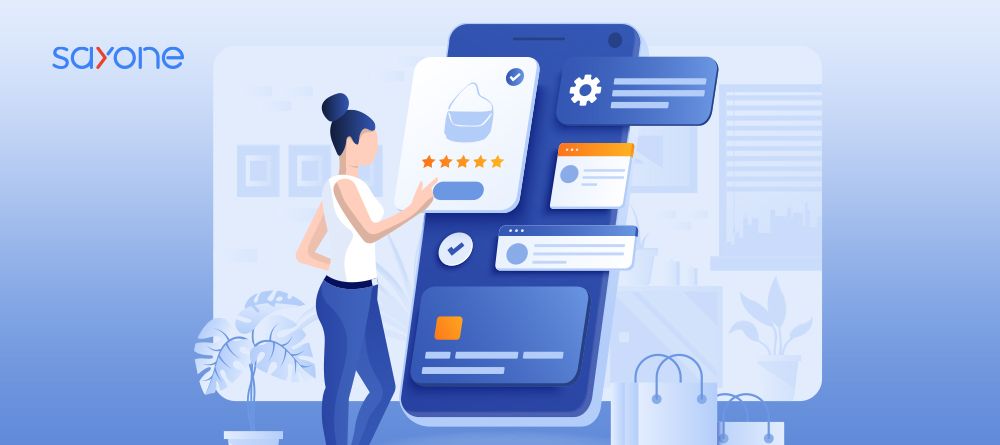
Subscribe to our Blog
We're committed to your privacy. SayOne uses the information you provide to us to contact you about our relevant content, products, and services. check out our privacy policy.

Akhil SundarAugust 14, 20239 min read

Generating table of contents...
In the ever-growing world of e-commerce, the user's shopping experience will determine whether to make or break a sale. An optimal e-commerce experience is one where users can effortlessly find and purchase the products they desire, fostering loyalty and repeat business. This critical factor hinges on Ecommerce UX or User Experience.
E-commerce UX is the design process that creates a satisfying and efficient interaction between the customer and the online store. It includes a website's layout, visuals, navigation, and overall functionality, aiming to provide an enjoyable and easy shopping experience. From product search to payment, every step should be user-friendly, accessible, and designed with the customer in mind.
A smooth and trouble-free shopping experience is crucial to customer satisfaction. It's about making the customer's journey from browsing to checkout as simple and enjoyable as possible. Any unnecessary complexity or friction can lead to cart abandonment and lost sales. Customers who are satisfied with your website experience are more likely to become loyal to your brand, recommend it to others, and return for more purchases. Ensuring a hassle-free experience is crucial in retaining customers and growing your online business.
Understanding User Behavior in Ecommerce is crucial for crafting a hassle-free shopping experience. Here's how it can be analyzed to ensure a smooth customer journey.
The user journey encompasses all the stages a customer goes through on an ecommerce website. From landing on the site to browsing products, adding them to the cart, and finally completing the purchase.
Analyzing this journey involves mapping out the process to
Tools like heatmaps and session recordings can provide valuable insights into where users click and how they navigate the site.
Key touchpoints are the critical interactions that users have with your ecommerce site. These can include product search, checkout, or customer service interactions. Understanding these touchpoints allows you to improve the overall user experience. Pain points, on the other hand, are the problems or frustrations users encounter.
These can lead to cart abandonment or losing trust in your brand. Identifying pain points involves actively seeking user feedback through surveys or user testing and monitoring areas where users seem to struggle. Whether you own a B2B marketplace platform or a B2C e-commerce website, addressing these pain points can lead to a more pleasant shopping experience, leading to increased sales and customer loyalty.
By analyzing the user journey and identifying key touchpoints and pain points, you can craft a more enjoyable and seamless online shopping experience for your customers. It aligns with the interests of those seeking to build an ecommerce store, aiding in attracting and retaining customers.
The design of your ecommerce platform plays a pivotal role in guiding users smoothly from browsing to checkout. Let's explore some of the foundational principles that drive a successful ecommerce user experience (UX).
An effective ecommerce site must offer clear and logical navigation. Your online store should guide the customers through the buying process with ease, and a well-structured information architecture helps customers find the products they're looking for without confusion. Simplifying categories and using descriptive labels can make browsing more pleasant for your shoppers.
As more consumers shop through mobile devices, your ecommerce site must be designed to function across different device sizes. A responsive, mobile-friendly design ensures your site looks and functions well on various screens.
Mobile-friendly design is not just about shrinking the website; it's about providing a smooth shopping experience, keeping buttons and text at a usable size, and making sure images load quickly. Adding slide designs can also improve the visual appeal and keep users more engaged on the site.
Read more on Why Mobile Commerce is the Future of eCommerce
Visual hierarchy aids users in quickly understanding the content by organizing elements in order of importance. In an ecommerce context, presenting products clearly is essential. Quality product images, concise descriptions, and noticeable call-to-action buttons provide clarity.
Using color, contrast, and space can guide the viewer's eyes and make navigation through your site more natural. You should also consider your branding elements and their design by investing in a logo maker or other branding tools.
For the ecommerce pet supplies store, we developed ‘MyFurBaby’. We built an engaging shopping experience through a responsive, mobile-friendly website that aligns with Google's Core Web Vitals. E-commerce businesses, to attract more customers, can try to embed Google Reviews on website for free by following an easy process.
MyFurBaby is explicitly designed for pet lovers; the UX elements focus on simple category selection for Dogs & Cats. Each product has an intuitive UI with a feeding guide, tips, and the option to subscribe. The site offers a user experience tailored to the needs of pet owners, delivering information and accessibility quickly and efficiently.
By focusing on these principles, you can create a more accessible and appealing online shopping environment for your customers. If you are in need of a UX design and development firm, Consult with SayOne Tech Experts today! Our core UX workflow starts with evaluating users' comfort and ease of shopping at the forefront. We can help you design the perfect UX ecosystem for your online store.
For an ecommerce store, a simplified checkout process can be the key to boosting conversions and retaining customers. A hassle-free shopping experience can be crafted by:
Check out email platforms Omnisend or Klaviyo that both provide A/B tests for signup forms to find what works best.
Crafting a user-friendly checkout process is essential for ecommerce success. By prioritizing user experience in the checkout flow, online businesses can see increased conversions and happier customers. Remember, every friction point can lead to abandoned carts, so keep it simple and efficient.
Utilizing user data to create tailored experiences is a key aspect of ecommerce UX. By understanding shoppers' behaviors and preferences, you can present products that resonate with their interests. This way, browsing becomes more relevant, encouraging increased engagement.
Product recommendations play an essential role in boosting sales. By suggesting related items or offering cross-selling options, you can guide customers to additional purchases that complement their selections. These recommendations can be based on their search terms, past purchases, browsing history, or popular items within the same category, creating a more targeted shopping experience.
Implementing wishlist and saved items features provides customers with the convenience of marking favorite products for later consideration. This not only helps in increasing return visits but also provides data on what products your customers intend to purchase. You can provide offers, add stocks or bring more product variations to match the demand.
By adding such a personalized approach, you can craft a more personalized and hassle-free shopping experience for your ecommerce store visitors. The ultimate goal is to make shopping more enjoyable and efficient, guiding customers to the products they desire and thus increasing both satisfaction and sales.
One of the essential aspects of crafting a hassle-free shopping experience in an e-commerce platform is the optimization of performance. Here's how it can be achieved:
Fast loading speeds are crucial for retaining visitors' interest in your e-commerce site. According to studies, a delay of even one second can reduce customer satisfaction. Therefore, loading speed optimization is a must, as it holds a direct impact on the user's shopping experience and, consequently, conversion rates.
The size and quality of images and content play a crucial role in the website's performance. High-quality images that are too large can slow down page loading. Opt for compressed image files that retain visual quality but reduce load times. Implementing responsive images and using suitable file formats can improve your site's performance and the core web vital score for better Search Engine Visibility.
Well-designed transitions and animations contribute to a positive user experience. They guide users through the interface and provide feedback, making the interaction feel natural and engaging. However, overusing animations can have the opposite effect. Ensure that the animations are subtle, purposeful, and well-executed to aid in navigation without hampering the site's performance.
Crafting a hassle-free shopping experience is key to achieving satisfied customers and increasing conversions. Focus on clear navigation, responsive design, simple checkout processes, and user-friendly interfaces. These strategies make shopping an enjoyable experience, directly influencing customer satisfaction and conversion rates.
If you're looking to build an effective e-commerce store with optimal UX design, SayOne Tech UX Design & Development Firm can be your go-to partner. Our expertise in creating satisfying and smooth shopping experiences can help turn your visitors into loyal customers.
Reach out to us today, and take the first step towards crafting the ideal e-commerce experience for your customers.

We're committed to your privacy. SayOne uses the information you provide to us to contact you about our relevant content, products, and services. check out our privacy policy.

About Author
Subject Matter Expert

We collaborate with visionary leaders on projects that focus on quality